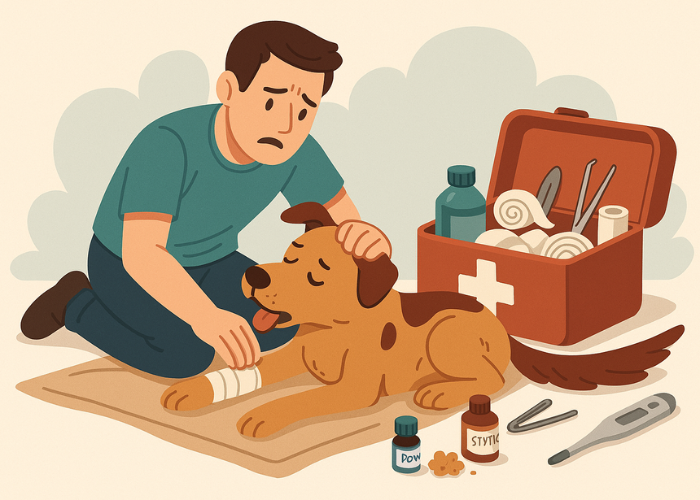Understanding Special Needs in Dogs
Every dog is unique, and some need a little extra care. Special Needs Dog Care refers to the ongoing support given to dogs with age-related challenges, disabilities (like blindness, deafness, or mobility issues), or chronic conditions such as diabetes, arthritis, or heart disease.
These dogs may require more patience, attention, and customized care routines, but they offer just as much love — often even more. Understanding your dog’s specific needs is the first step toward giving them the best life possible.
Adapting Daily Routines
Caring for a dog with special needs means rethinking your day-to-day habits and routines. Here are some foundational areas you’ll want to adjust:
🕒 1. Consistent Scheduling
Dogs with cognitive decline or sensory loss rely on routine to feel secure. Feed, walk, and administer medications at the same times each day.
🛏️ 2. Comfort and Accessibility at Home
- Provide orthopedic bedding
- Use non-slip mats to prevent falls
- Create designated quiet zones
- Keep furniture layout consistent for blind dogs
🍽️ 3. Diet and Hydration
Senior and chronically ill dogs often require special diets. Diabetic dogs, for example, need balanced meals low in sugar and given on a strict schedule. Hydration is also crucial — keep water bowls full and easily reachable.
Mobility and Accessibility Solutions
Physical limitations don’t have to mean a lower quality of life. Simple mobility adaptations can go a long way in supporting dogs with arthritis, joint pain, or paralysis.
🔧 Helpful tools:
- Dog ramps and stairs: Great for getting on beds, sofas, or into cars
- Harnesses with lift handles: Assist in getting up or walking
- Wheelchairs or carts: Provide freedom of movement for paralyzed or weak-limbed dogs
- Toe grips or booties: Improve traction for dogs with unstable gait
Making mobility easier doesn’t just support their body — it uplifts their spirit.
Caring for Visually and Hearing-Impaired Dogs
Dogs who can’t see or hear can still live rich, fulfilling lives. They just need a few environmental tweaks and consistent communication strategies.
🦮 Blind Dogs:
- Avoid rearranging furniture
- Use scent markers (lavender drops, pet-safe oils) near key areas
- Announce your presence verbally or with gentle touch
- Train with texture: rugs or mats as “maps” for rooms
🐶 Deaf Dogs:
- Use hand signals or flashlight cues
- Teach tactile communication (e.g., light taps to signal commands)
- Avoid sneaking up to prevent startle responses
- Fence your yard or use a leash outdoors
Most importantly, keep your body language calm and confident — dogs are experts at reading your emotions.
Managing Chronic Illnesses
When your dog is living with a chronic condition, such as diabetes, heart disease, or arthritis, consistent care and monitoring become essential.
💉 Diabetes:
- Feed meals at fixed times
- Administer insulin exactly as prescribed
- Monitor glucose levels and be alert to signs of hypoglycemia (weakness, trembling, confusion)
❤️ Heart Disease:
- Provide low-sodium food
- Limit strenuous activity
- Administer medications regularly
- Watch for symptoms like coughing or fainting
🦴 Arthritis:
- Use anti-inflammatory medications under vet supervision
- Encourage low-impact exercise (like swimming or short walks)
- Provide padded surfaces and keep the home warm
Always maintain a close relationship with your veterinarian. Adjustments to care plans may be needed over time, and early detection of changes in behavior or symptoms can prevent emergencies.
Emotional and Behavioral Support
Caring for a special needs dog isn’t just physical — their emotional well-being matters just as much.
Dogs with sensory loss, chronic pain, or cognitive issues may experience:
- Anxiety
- Confusion
- Frustration
- Restlessness
💡 Ways to support their mental health:
- Use puzzle toys and scent games for enrichment
- Stick to routines to provide structure and security
- Avoid punishment — use redirection and positive reinforcement instead
- Offer calm spaces where they can relax undisturbed
Give lots of love, attention, and encouragement. Your dog may not be able to say “thank you,” but they’ll show it in tail wags, licks, and snuggles.
Tools and Products That Help
Here are some helpful items that make Special Needs Dog Care easier for both dog and owner:
| Item | Purpose |
|---|---|
| Orthopedic dog bed | Supports joints and relieves pressure |
| Elevated food/water bowls | Easier access for dogs with neck or back pain |
| Belly bands/diapers | For dogs with incontinence issues |
| Pet stairs or ramps | Reduces strain on joints for accessing furniture or cars |
| Muzzle with mesh panels | Safe for vet visits in dogs with pain-based aggression |
| Medical alert tags | Show that your dog is blind, deaf, or has a condition |
Every small adjustment adds up to a big improvement in daily comfort and safety.
Tips for Caregivers and Families
Caring for a special needs dog can be deeply fulfilling, but it also comes with emotional and physical demands. Here’s how to support both your dog and yourself:
👨👩👧👦 Involve the Whole Family
Assign age-appropriate tasks to family members:
- Kids can fill water bowls
- Teens can help with short walks or grooming
- Adults manage vet appointments and medications
⏳ Take Breaks
Use pet sitters or trusted friends to give yourself rest when needed. Caregiver fatigue is real — and recharging helps you show up better for your dog.
🤝 Join a Support Group
Connect with others caring for special needs pets. Sharing experiences, tips, and encouragement can be incredibly helpful.
Conclusion: A Life Full of Meaning, One Day at a Time
Caring for a dog with special needs is a journey filled with patience, learning, and love. It’s not always easy — but it’s always worth it.
Whether your dog is aging, managing a lifelong condition, or living with a disability, they can thrive in the right environment. With informed, thoughtful care, your pet can live a life full of comfort, confidence, and connection.
Keep learning. Keep adapting. Keep loving.
Because Special Needs Dog Care isn’t just about medical support — it’s about giving your dog the happiest life possible, no matter what challenges they face.



